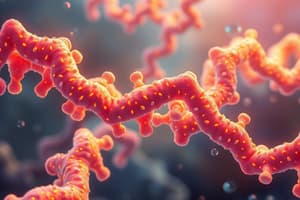Podcast
Questions and Answers
What is co-translational modification in protein synthesis?
What is co-translational modification in protein synthesis?
- Activation of proteins through enzymatic action.
- Chemical changes that happen while the protein is attached to the ribosome. (correct)
- The removal of a peptide segment from an inactive protein.
- Modifications that occur after protein synthesis is complete.
Which organelles are primarily involved in post-translational modifications?
Which organelles are primarily involved in post-translational modifications?
- Lysosomes and peroxisomes
- Ribosomes and cytoplasm
- Endoplasmic Reticulum and Golgi apparatus (correct)
- Nucleus and mitochondria
What is a key function of chaperone proteins?
What is a key function of chaperone proteins?
- To enhance the speed of translation.
- To assist in the proper folding of proteins. (correct)
- To degrade misfolded proteins.
- To modify proteins by adding lipid groups.
What process converts pre-proinsulin into insulin?
What process converts pre-proinsulin into insulin?
Which of the following modifications adds a phosphate group to a protein?
Which of the following modifications adds a phosphate group to a protein?
Which type of modification is responsible for adding a carboxylic group to a protein?
Which type of modification is responsible for adding a carboxylic group to a protein?
What is a possible consequence of protein misfolding?
What is a possible consequence of protein misfolding?
What kind of modifications can proteins undergo via covalent modification?
What kind of modifications can proteins undergo via covalent modification?
What role does interferon play in the translational process?
What role does interferon play in the translational process?
Which of the following substances inhibits protein synthesis by affecting elongation?
Which of the following substances inhibits protein synthesis by affecting elongation?
What is the function of protein phosphatases?
What is the function of protein phosphatases?
Which of the following processes is required for the maturation of collagen?
Which of the following processes is required for the maturation of collagen?
Heme influences protein synthesis by preventing what process?
Heme influences protein synthesis by preventing what process?
What impact does the carboxylation of proteins have in the human body?
What impact does the carboxylation of proteins have in the human body?
Which mechanism of action of antibiotics is involved in the regulation of protein synthesis?
Which mechanism of action of antibiotics is involved in the regulation of protein synthesis?
What is the primary consequence of diphtheria toxin's action on EF-2?
What is the primary consequence of diphtheria toxin's action on EF-2?
What is the primary site for post-translational modifications in cells?
What is the primary site for post-translational modifications in cells?
Which of the following accurately describes the purpose of protein chaperones?
Which of the following accurately describes the purpose of protein chaperones?
What type of modification involves the addition of a hydroxyl group to amino acids in proteins?
What type of modification involves the addition of a hydroxyl group to amino acids in proteins?
Which condition can result from the abnormal folding of proteins?
Which condition can result from the abnormal folding of proteins?
What is one of the consequences of covalent modification of proteins?
What is one of the consequences of covalent modification of proteins?
What role does glycosylation play in protein modification?
What role does glycosylation play in protein modification?
Which process refers to the removal of part of the peptide chain from a protein?
Which process refers to the removal of part of the peptide chain from a protein?
Phosphorylation of proteins is particularly significant for which purpose?
Phosphorylation of proteins is particularly significant for which purpose?
What effect does interferon have on the translational process?
What effect does interferon have on the translational process?
Which enzyme is responsible for catalyzing the dephosphorylation of proteins?
Which enzyme is responsible for catalyzing the dephosphorylation of proteins?
What is the primary function of diphtheria toxin in the context of protein synthesis?
What is the primary function of diphtheria toxin in the context of protein synthesis?
How does heme influence globin synthesis?
How does heme influence globin synthesis?
What role do protein kinases play in the regulation of translation?
What role do protein kinases play in the regulation of translation?
Which of the following statements accurately describes the effect of antibiotics on protein synthesis?
Which of the following statements accurately describes the effect of antibiotics on protein synthesis?
What does the carboxylation of proteins contribute to in the human body?
What does the carboxylation of proteins contribute to in the human body?
Which aspect of protein synthesis is primarily controlled at the initiation stage?
Which aspect of protein synthesis is primarily controlled at the initiation stage?
What are the two main types of modifications that proteins undergo post-translationally?
What are the two main types of modifications that proteins undergo post-translationally?
Why do some proteins require chaperones for proper folding?
Why do some proteins require chaperones for proper folding?
Give an example of a protein that undergoes trimming in post-translational processing.
Give an example of a protein that undergoes trimming in post-translational processing.
What modifications can occur through covalent modification of proteins?
What modifications can occur through covalent modification of proteins?
How does phosphorylation affect the activity of proteins?
How does phosphorylation affect the activity of proteins?
What is the significance of glycosylation in protein function?
What is the significance of glycosylation in protein function?
What is one consequence of protein abnormal folding?
What is one consequence of protein abnormal folding?
Describe the role of the endoplasmic reticulum in post-translational modifications.
Describe the role of the endoplasmic reticulum in post-translational modifications.
How does phosphorylation by protein kinases influence cellular processes?
How does phosphorylation by protein kinases influence cellular processes?
What is the role of protein phosphatases in cellular functions?
What is the role of protein phosphatases in cellular functions?
In what way does heme affect the synthesis of globin?
In what way does heme affect the synthesis of globin?
Describe the impact of diphtheria toxin on protein synthesis.
Describe the impact of diphtheria toxin on protein synthesis.
How does interferon modulate protein synthesis at the initiation level?
How does interferon modulate protein synthesis at the initiation level?
What is the consequence of carboxylation in the maturation of proteins?
What is the consequence of carboxylation in the maturation of proteins?
Explain the role of glycosylation in protein modification.
Explain the role of glycosylation in protein modification.
What is the significance of controlling the translational process in response to viral infections?
What is the significance of controlling the translational process in response to viral infections?
How do protein kinases specifically influence protein function?
How do protein kinases specifically influence protein function?
Discuss the effect of interferon on viral protein synthesis.
Discuss the effect of interferon on viral protein synthesis.
What is the role of EF-2 in protein synthesis, and how does diphtheria toxin affect it?
What is the role of EF-2 in protein synthesis, and how does diphtheria toxin affect it?
Explain the significance of carboxylation in the maturation of proteins.
Explain the significance of carboxylation in the maturation of proteins.
How does heme interact with the synthesis of globin at a translational level?
How does heme interact with the synthesis of globin at a translational level?
What mechanism explains the action of antibiotics on bacterial protein synthesis?
What mechanism explains the action of antibiotics on bacterial protein synthesis?
In what way do protein phosphatases counter the action of protein kinases?
In what way do protein phosphatases counter the action of protein kinases?
Describe how post-translational modifications can impact the pathophysiology of diseases.
Describe how post-translational modifications can impact the pathophysiology of diseases.
What role do chaperones play in protein folding, and why might certain proteins require them?
What role do chaperones play in protein folding, and why might certain proteins require them?
Describe the process of trimming in post-translational modifications and give an example.
Describe the process of trimming in post-translational modifications and give an example.
Why is phosphorylation considered a significant post-translational modification, and what effect does it have on proteins?
Why is phosphorylation considered a significant post-translational modification, and what effect does it have on proteins?
What is glycosylation, and how does it impact protein function?
What is glycosylation, and how does it impact protein function?
Explain the significance of correctly folded proteins in relation to diseases such as Alzheimer's.
Explain the significance of correctly folded proteins in relation to diseases such as Alzheimer's.
What are covalent modifications, and how do they influence protein activity?
What are covalent modifications, and how do they influence protein activity?
Discuss the impact of improper post-translational modifications on protein stability.
Discuss the impact of improper post-translational modifications on protein stability.
In what way do the endoplasmic reticulum and Golgi apparatus collaborate during post-translational processing?
In what way do the endoplasmic reticulum and Golgi apparatus collaborate during post-translational processing?
Flashcards
Post-translational modifications
Post-translational modifications
Chemical modifications of a protein after its synthesis.
Protein folding
Protein folding
Polypeptide chain acquiring its 3D structure to function properly.
Protein trimming
Protein trimming
Removing parts of a polypeptide chain.
Zymogen activation
Zymogen activation
Signup and view all the flashcards
Covalent modification
Covalent modification
Signup and view all the flashcards
Phosphorylation
Phosphorylation
Signup and view all the flashcards
Hydroxylation
Hydroxylation
Signup and view all the flashcards
Carboxylation
Carboxylation
Signup and view all the flashcards
Glycosylation
Glycosylation
Signup and view all the flashcards
Protein Chaperones
Protein Chaperones
Signup and view all the flashcards
Protein Phosphorylation
Protein Phosphorylation
Signup and view all the flashcards
Protein Hydroxylation
Protein Hydroxylation
Signup and view all the flashcards
Protein Carboxylation
Protein Carboxylation
Signup and view all the flashcards
Protein Glycosylation
Protein Glycosylation
Signup and view all the flashcards
Protein kinases
Protein kinases
Signup and view all the flashcards
Protein phosphatases
Protein phosphatases
Signup and view all the flashcards
Initiation Factors (IF-2)
Initiation Factors (IF-2)
Signup and view all the flashcards
Elongation Factor 2 (EF-2)
Elongation Factor 2 (EF-2)
Signup and view all the flashcards
Post-translational Processing
Post-translational Processing
Signup and view all the flashcards
Regulation of Translation
Regulation of Translation
Signup and view all the flashcards
Post-translational processing
Post-translational processing
Signup and view all the flashcards
Protein folding
Protein folding
Signup and view all the flashcards
Protein trimming
Protein trimming
Signup and view all the flashcards
Zymogen activation
Zymogen activation
Signup and view all the flashcards
Covalent modification
Covalent modification
Signup and view all the flashcards
Phosphorylation
Phosphorylation
Signup and view all the flashcards
Hydroxylation
Hydroxylation
Signup and view all the flashcards
Carboxylation
Carboxylation
Signup and view all the flashcards
Glycosylation
Glycosylation
Signup and view all the flashcards
Protein Chaperones
Protein Chaperones
Signup and view all the flashcards
Protein Kinases
Protein Kinases
Signup and view all the flashcards
Protein Phosphatases
Protein Phosphatases
Signup and view all the flashcards
IF-2
IF-2
Signup and view all the flashcards
EF-2
EF-2
Signup and view all the flashcards
Translation Regulation
Translation Regulation
Signup and view all the flashcards
Protein Hydroxylation
Protein Hydroxylation
Signup and view all the flashcards
Protein Carboxylation
Protein Carboxylation
Signup and view all the flashcards
Protein Glycosylation
Protein Glycosylation
Signup and view all the flashcards
Post-translational Processing
Post-translational Processing
Signup and view all the flashcards
Protein Folding
Protein Folding
Signup and view all the flashcards
Protein Trimming
Protein Trimming
Signup and view all the flashcards
Zymogen Activation
Zymogen Activation
Signup and view all the flashcards
Covalent Modification
Covalent Modification
Signup and view all the flashcards
Phosphorylation
Phosphorylation
Signup and view all the flashcards
Hydroxylation
Hydroxylation
Signup and view all the flashcards
Carboxylation
Carboxylation
Signup and view all the flashcards
Glycosylation
Glycosylation
Signup and view all the flashcards
Protein Kinases
Protein Kinases
Signup and view all the flashcards
Protein Phosphatases
Protein Phosphatases
Signup and view all the flashcards
IF-2
IF-2
Signup and view all the flashcards
EF-2
EF-2
Signup and view all the flashcards
Translation Regulation
Translation Regulation
Signup and view all the flashcards
Protein Hydroxylation
Protein Hydroxylation
Signup and view all the flashcards
Carboxylation of Protein
Carboxylation of Protein
Signup and view all the flashcards
Protein Glycosylation
Protein Glycosylation
Signup and view all the flashcards
Post-translational Processing
Post-translational Processing
Signup and view all the flashcards
Post-translational Processing
Post-translational Processing
Signup and view all the flashcards
Protein Folding
Protein Folding
Signup and view all the flashcards
Protein Trimming
Protein Trimming
Signup and view all the flashcards
Zymogen Activation
Zymogen Activation
Signup and view all the flashcards
Covalent Modification
Covalent Modification
Signup and view all the flashcards
Phosphorylation
Phosphorylation
Signup and view all the flashcards
Hydroxylation
Hydroxylation
Signup and view all the flashcards
Carboxylation
Carboxylation
Signup and view all the flashcards
Glycosylation
Glycosylation
Signup and view all the flashcards
Protein Kinases
Protein Kinases
Signup and view all the flashcards
Protein Phosphatases
Protein Phosphatases
Signup and view all the flashcards
IF-2
IF-2
Signup and view all the flashcards
EF-2
EF-2
Signup and view all the flashcards
Translation Regulation
Translation Regulation
Signup and view all the flashcards
Protein Hydroxylation
Protein Hydroxylation
Signup and view all the flashcards
Protein Carboxylation
Protein Carboxylation
Signup and view all the flashcards
Protein Glycosylation
Protein Glycosylation
Signup and view all the flashcards
Post-translational Processing
Post-translational Processing
Signup and view all the flashcards
Protein Folding
Protein Folding
Signup and view all the flashcards
Study Notes
Protein Modifications (Processing)
- Protein modifications occur either co-translationally (while attached to ribosome) or post-translationally (after synthesis).
- Post-translational processing modifies polypeptides or amino acid residues after protein synthesis.
- The modifications occur in endoplasmic reticulum and Golgi apparatus.
- Protein folding is crucial for protein function.
- Secondary, tertiary, and quaternary structures are formed through folding.
- Some proteins need chaperones to fold correctly.
- Improper folding can lead to diseases like Alzheimer's.
Protein Trimming
- Trimming involves removing parts of the peptide chain.
- This process converts inactive proteins to active forms.
- Examples include pre-proinsulin converting to insulin and inactive pancreatic trypsinogen becoming active trypsin.
- Proteins may be activated or inactivated by adding chemical groups to their amino acids.
Covalent Modification
- Chemical groups are attached covalently to the protein.
- Examples include phosphorylation, hydroxylation, carboxylation, and glycosylation.
- Phosphorylation adds a phosphate group.
- Hydroxylation adds a hydroxyl group to proline.
- Carboxylation adds a carboxyl group to glutamate.
- Glycosylation adds a carbohydrate group.
Regulation of Translation
- Translation process is regulated by initiation factors (IF-2).
- Interferon (anti-viral drug) stimulates IF-2 phosphorylation, inhibiting viral replication.
- Heme increases globin synthesis by preventing IF-2 phosphorylation.
- Diphtheria toxin inhibits elongation factor 2 (EF-2), inhibiting protein synthesis.
Clinical Correlates
- Some drugs affect protein synthesis rate.
- Interferon stimulates IF-2 phosphorylation, decreasing viral protein synthesis.
- Antibiotics can inhibit protein synthesis at various stages within bacterial cells.
- Diphtheria toxin inhibits EF-2, preventing translocation, and causing cell death.
Translation Inhibitors (Antibiotics)
- Antibiotics target bacterial protein synthesis.
- Streptomycin interferes with initiation or misreads mRNA.
- Tetracycline blocks the A site, preventing aminoacyl-tRNA binding.
- Erythromycin inhibits translocation.
- Puromycin causes premature termination.
Studying That Suits You
Use AI to generate personalized quizzes and flashcards to suit your learning preferences.





